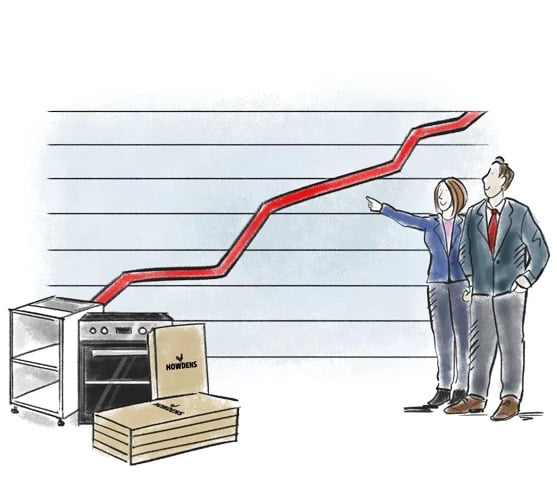2011 Preliminary Results
01 March 2012
The information presented in this document relates to the 52 weeks to 24 December 2011 and the 52 weeks to 25 December 2010, unless otherwise stated.
HIGHLIGHTS
"Howdens has delivered another good set of results in 2011."
"We have achieved this in demanding market conditions by our relentless focus on the core strengths of our business model. We have had the confidence to invest in our business operations to deliver this performance and we have continued to pursue the growth opportunities that we see before us. We are recommending a dividend for the first time in four years, reflecting the robust financial position of the Group and our confidence in Howdens´ successful future."
"We expect market conditions to continue to be challenging and remain cautious about the immediate outlook."
Financial results (continuing operations 1)
- Howden Joinery UK depot revenue increased by 5.5% to £838.7m (up 3.1% on same depot basis). Group revenue was £853.8m (2010: £807.9m);
- Gross profit margin little changed at 59.5% (2010: 59.8%);
- Operating profit rose from £107.4m to £114.3m, partly reflecting one-off cost benefits totalling £5m;
- Profit before tax increased to £110.0m (2010: £100.9m);
- Basic earnings per share increased from 11.1p to 13.4p;
- Net cash of £57.1m at year-end (25 December 2010: £35.0m net cash);
- Full year dividend of 0.5p per share recommended.
1 There was an exceptional loss before tax from discontinued operations of £8.3m in 2011, arising from an increase in the legacy property provision and associated costs. Profit before tax from continuing and discontinued operations was £101.7m (2010: £100.9m).
Business developments
- Investment in the future growth of the business continues:
- 20 new depots opened in 2011, bringing total to 509;
- capital expenditure totalled £19.6m;
- £7.6m investment in operating costs to support growth, including over 170 additional staff in existing depots, new product introduction and marketing initiatives;
- Leases on 17 legacy properties terminated in 2011, bringing total remaining to 21 at year-end;
- Further mitigation of legacy property liability, with termination of the lease on one more legacy property since the 2011 Year-End Update, issued in January 2012, bringing the total to two for the year-to-date.
Current trading
- Howden Joinery UK depot revenue in the first two periods of 2012 rose by 1.6%, up 0.1% on a same depot basis, reflecting tough comparator from 2011 – pattern and volume of sales in line with management expectations;
- Remain cautious about the immediate outlook.
SUMMARY OF GROUP RESULTS
| Continuing operations 1, £m unless stated |
2011 |
2010 |
| Revenue - Group |
853.8 | 807.9 |
| - Howden Joinery UK depots | 838.7 | 795.1 |
|
Gross profit |
508.3 |
483.0 |
| Gross profit margin, % | 59.5 | 59.8 |
| Operating profit | 114.3 | 107.4 |
| Profit before tax | 110.0 | 100.9 |
| Loss before tax from discontinued operations – exceptional item | (8.3) | - |
| Basic earnings per share from continuing operations | 13.4p | 11.1p |
| Basic earnings per share from continuing and discontinued operations |
12.1p |
11.1p |
| Dividend per share | 0.5p | - |
| Net cash at end of period | 57.1 | 35.0 |
1 There were no exceptional items from continuing operations in 2010 and 2011, or from discontinued operations in 2010.
FINANCIAL REVIEW
FINANCIAL RESULTS FOR 2011
The financial performance of the Group during 2011 benefited from the Group´s competitive position and actions taken to improve performance.
Total Group revenue increased by £45.9m to £853.8m.
| Revenue £m | 2011 | 2010 |
| Group | 853.8 | 807.9 |
| comprising: Howden Joinery UK depots Howden Joinery French depots |
838.7 15.1 |
795.1 12.8 |
Howden Joinery UK depot revenue rose by 5.5% to £838.7m, increasing 3.1% on a same depot basis.
In demanding market conditions, this growth was achieved through a number of factors, including a significant increase in the number of customer accounts. The value of kitchen (furniture, worktops, sinks & taps and appliances) sales rose partly as a result of a higher proportion of mid and higher priced ranges being sold. Also, the value of door sales increased as the mix changed and the volume of sales of joinery and flooring increased substantially. In addition, selling prices were increased to help offset higher input costs.
Sales by our ten French depots of £15.1m were up over 15% in constant currency terms.
Gross profit rose by £25.3m to £508.3m. As a result, the gross profit margin for the year of 59.5% was little changed (2010: 59.8%), despite higher input prices.
Selling and distribution costs, and administrative and other operating expenses increased by £18.4m to £394.0m. This reflects the costs of new depots, investment in growth, including additional staffing in existing depots, new product introduction and increased marketing expenditure, and the impact of inflation, particularly on payroll costs.
It should be noted that within operating costs there were certain credits in 2011 totalling around £5m that were ´one-off´ in nature. For example: improved debt collection has allowed us to revise our provisioning policy for bad debt; in a number of instances, we achieved better than expected terms when negotiating revised property leases; and a change of electricity supplier to our depots and the introduction of ´smart meters´ means that we can more precisely account for energy costs.
Operating profit from continuing operations increased by £6.9m to £114.3m.
The net interest charge fell by £2.2m to £4.3m, due mainly to the reduced finance expense in respect of pensions and the lower level of debt during 2011. The net result was profit before tax from continuing operations rose by £9.1m to £110.0m. For 2012, the finance expense in respect of pensions will increase by £4m.
There was an exceptional loss attributable to discontinued operations before tax of £8.3m, in respect of the provision relating to legacy properties and associated costs.
The tax charge on profit before tax from continuing operations was £28.9m, an effective rate of tax of 26.3%. There was a tax credit of £0.5m in respect of the loss from discontinued operations.
Basic earnings per share from continuing operations were 13.4p (2010: 11.1p). Basic earnings per share from continuing and discontinued operations were 12.1p (2010: 11.1p).
At 24 December 2011, the pension deficit shown on the balance sheet was £136.9m (25 December 2010: £135.7m). The impact of changes in assumptions, including a decrease in the discount rate, and lower than expected asset returns was mostly offset by the Company´s contribution made as part of the 2009 agreement to clear the actuarial deficit. The triennial actuarial review of the pension scheme as at 1 April 2011 is being undertaken currently on behalf of the trustees.
There was a net cash inflow from operating activities of £40.2m. This included payments relating to ´legacy´ properties totalling £29.4m and a cash contribution to the Group´s pension schemes, in excess of the operating charge, of £33.3m.
Excluding the ´legacy´ property payments, underlying working capital movements caused a cash outflow of £9.4m. Within this, stock levels at the end of the year were £13.0m higher than at the end of 2010. This was partly offset by an increase in creditors of £3.9m, the level of debtors being virtually unchanged despite sales growing in the year. In respect of debtors, we have seen an improvement in the age-profile of debtors and a reduction in the level of bad debt write-off.
Also included within net cash flows from operating activities was tax paid totalling £22.5m.
Payments to acquire fixed and intangible assets totalled £19.6m (2010: £18.2m).
Reflecting the above, there was a net cash inflow of £22.1m in 2011, the Group having net cash of £57.1m at the end of the year (25 December 2010: £35.0m net cash). Excluding the payments relating to ´legacy´ properties and the pension deficit contribution, there was a cash inflow of £84.8m.
DIVIDEND
As a growing business in an increasingly complex and sophisticating market, reinvestment is a strategic priority for Howdens. At the same time, the Group still has significant, ongoing ´legacy´ commitments relating both to pension deficit funding, and to the rent and rates associated with a diminishing number of leases of unoccupied properties. Taken together, these legacy commitments, together with sums paid to terminate leases, required a £62.7m cash contribution from the business during 2011.
Against this background, the Board has decided to resume payment of the dividend, and is recommending a full year dividend of 0.5p per share.
In reaching this decision, the Board has taken account of a number of factors, including its desire to signal its confidence in the longer term prospects of the business and to reward shareholders. In recommending this prudent level of dividend, it has taken into account: the opportunities we see to invest in the growth of the business, through the opening of new depots and investment in our UK manufacturing operations, and fund deals to terminate leases on legacy properties, both of which should deliver good returns; the need to contribute to the legacy pension deficit; and our desire to maintain a strong balance sheet given prevailing economic conditions, all of which the Board believes to be in the best interest of shareholders.
It is expected that similar considerations will influence the Board´s approach to the dividend in respect of the current financial year.
OPERATIONAL REVIEW
The business model of Howden Joinery is “To supply from local stock nationwide the small builder´s ever-changing routine kitchen and joinery requirements, assuring no-call-back quality and best local price".
In July 2010, in our Half Yearly Report, we said that the opportunity to transform the scale of the business was apparent and that, as the performance of the business was improving and legacy issues were diminishing, we were stepping up investment in the future growth of Howden Joinery.
Since then, this investment in growth has not only seen a step-up in capital expenditure but also increased expenditure in a number of other areas, to support the growth of the business and its performance in demanding market conditions.
Depot network
During the course of 2011, 20 new depots were opened, bringing the total trading at the end of the year to 509. In addition, two depots were relocated and seven depots were extended.
Staffing levels were increased in existing depots of all ages to facilitate their growth, numbers growing by over 170 during the year. A significant proportion of these were related to the introduction of hardware/flooring vans (see below).
Product and marketing
We continue to enhance our product offering. During the course of the year, we introduced five new kitchen ranges: the popular Burford range was extended with two new colourways, Grey and Maple; two integrated handle designs were introduced; and a new colourway, Skye, was added to the Tewkesbury family. In addition, we updated a number of existing ranges.
In response to the increasing sophistication of kitchens, we enhanced our kitchen cabinetry. Foremost amongst a number of developments were the introduction of extra tall wall units and a light oak cabinet to replace the previous beech cabinet.
Supporting sales of our Lamona kitchen appliances, we introduced a two-year guarantee across the range.
In our door and joinery collection, we introduced a number of products based on our best selling Burford and Greenwich ranges. In our flooring collection, we enhanced this further with improvements to the laminate and timber offering.
To support the upgrading of our joinery products, early in the year we introduced a small number of hardware and flooring vans that can display products and support the depots in the field. After the initial trial, the vans were combined and the fleet of vans was increased in two phases, so that now over 110 depots have a hardware/flooring van supporting their sales and marketing. This means that, along with depot sales representatives, we now have 700 field employees servicing our more than 250,000 account holders and looking for new business opportunities.
Throughout the year, we held a proactive series of roadshows with our kitchen designers and other depot staff to help inform our new product development programme. These roadshows considered how sales of various product categories could be improved, learning from successful existing products and identifying gaps in our offering. New products were presented to our depot staff at a series of major events, prior to their introduction. These events included demonstrating the versatility of our Lamona appliances by showing them being used by a top chef.
Manufacturing and logistics operations
As part of a £20m two-year programme of investment in our manufacturing sites in Runcorn and Howden, orders were placed for a new cabinet production line at each site. Work has begun on these at the supplier´s plant, with the first phase of assembly in our factories due to begin in the second quarter of 2012. In addition, a project automating assembly lines at Runcorn, begun in 2010, has been completed.
Implementation of a new warehouse management system in all three of our distribution centres was completed with the installation at our Howden site.
General
New central computers and data storage systems were installed in our main data centre in Northampton and back-up data centre in Harrogate.
A major IT project to simplify and upgrade SAP systems dealing with financial control, credit control and supply chain management, that had been introduced originally in 2004, was successfully completed.
GROUP DEVELOPMENTS
Legacy properties
The Group continues to reduce its ´legacy property´ portfolio.
During 2011, the leases of 17 properties were terminated, at a cost of £17.9m, mitigating future liabilities that would have totalled over £55m. In addition, two leases expired during the year. Since the year-end, the leases of two properties have been terminated at a cost of £7.6m, mitigating future liabilities that would have totalled nearly £20m.
As a result, the number of legacy properties now stands at 19, compared with 40 at the end of 2010. Included within this are nine properties that are fully or part occupied by tenants.
The profile of properties remaining and the net annual rent and rates (current values) for the associated leases going forward, before any mitigating action is taken, is shown below.
| Current |
As at 31 Dec 2012 |
31 Dec 2014 |
31 Dec 2019 |
31 Dec 2024 |
|
| Number of properties1 | 19 | 19 | 10 | 6 | 23 |
| Net annual rent and rates, £m2 | 5.7 | 5.7 | 3.1 | 2.2 | 0.2 |
Estimated future costs associated with these properties were originally provided for in 2009 and previous years. An additional amount of £7.7m was provided for in 2011.
- Vacant and tenanted.
- Gross rent & rates less payments by tenants.
- All remaining leases expire during the course of 2025.
CURRENT TRADING AND OUTLOOK FOR 2012
Howden Joinery UK depot sales in the first two periods of 2012 (to 17 February) were up 1.6% on the same periods last year, with sales on a same depot basis up by 0.1%, the pattern and volume of sales in the two periods being in line with our expectations.
Taking into account last year´s initiative to target the busy post-Christmas trading period of the non-trade kitchen market, which pulled sales forward in to the first two periods of 2011, and forward looking indicators of depot activity, it seems that trading conditions and our performance remain much as they were in 2011, at this early stage of the year.
For the rest of 2012, we expect market conditions to continue to be challenging and we remain cautious about the outlook. As in recent years, we will quickly and appropriately adapt our business model to the market and economic conditions we encounter.
The Group remains committed to its view that the number of depots in the UK can be increased from its current level of 509 and now believes that this number could be around 700. During the course of 2012, we are currently planning to open around 20 depots as part of our investment in the next stage of Howdens´ longer term growth and development.
Since its inception in 1995, Howden Joinery has grown rapidly and has gained a significant share of the UK kitchen market. Today, it sells some 400,000 kitchens a year. Even in these challenging market conditions, we would expect our market share growth to continue, as the business continues to benefit from the growth of our depots that have yet to reach maturity and we open new depots.
Note: The 2012 financial year will include a 53rd week, ending 29 December, 2012. It is estimated that the impact of the additional week will be to increase operating costs by around £6m, revenue remaining unchanged as our depots are closed between Xmas and New Year. Because of the timing of month-end creditor payments, the impact on cash flow is estimated to be £25m.
GOING CONCERN
The Group meets its day to day working capital requirements through an asset backed lending facility of £160m, which is due for renewal in May 2014. The current economic conditions create uncertainty, particularly over (a) the level of demand for the Group´s products and, (b) the exchange rate between sterling and both the Euro and the US Dollar, which would affect the cost of the Group´s operations.
The Group´s forecasts and projections have been stress-tested for reasonably possible adverse variations in trading performance. The results of this testing show that the Group should be able to operate within the level of its current facility and covenants. The Group´s banking facility expires in May 2014, so at this stage the Group has not sought any written commitment that the facility will be renewed. We will open renewal negotiations with the banks in due course.
After making due enquiries, and in accordance with the FRC´s "Going Concern and Liquidity Risk: Guidance for Directors of UK Companies 2009", the directors have a reasonable expectation that the Company and the Group have adequate resources to continue in operational existence for the foreseeable future. Accordingly, they continue to adopt the going concern basis in preparing the accounts.
PRINCIPAL RISKS AND UNCERTAINTIES
The Board considers that the Group´s principal risks and uncertainties, together with an indication of actions taken to manage and mitigate them, are as detailed below. They do not comprise all risks associated with the Group, and are not set out in any order of priority. Additional risks not presently known to management or currently deemed to be less material may also have an adverse affect on the Group´s business in the future.
Market conditions
The Group´s products are predominantly sold to small local builders for installation in public and private housing, mainly in the repair, maintenance and improvement markets.
The Group´s results are consequently dependent on levels of activity in these markets, which are impacted by many factors including general economic conditions, consumer confidence, interest rates and credit availability, unemployment, demographic trends and, in the short term, weather. A severe downturn in market conditions could impact on our ability to achieve our sales and profit forecasts. This could in turn put pressure on our cash availability and banking covenants.
We monitor the market closely and can take swift management action as necessary in response to adverse changes, with the aim that the business is aligned to market conditions and, consequently, that we should have sufficient cash facilities for business needs and adequate covenant headroom.
Failure to implement the Group´s business model and culture
The future success of the business depends on the successful implementation of the Group´s business model and locally-enabled, entrepreneurial culture.
In particular, if the Group fails to implement its business model in the locally enabled, decentralised manner envisaged, there may be an adverse affect on the Group´s future financial condition and profitability.
Led by the actions of the Board and Executive Committee, the business model and the Howdens culture are at the centre of the activities and the decision-making processes of the Group, and are continually emphasised. The Executive and senior management regularly visit our depots and factories, and hold regular events during which they reinforce the importance of the Group´s business model and culture. Throughout the business, successful implementation of the Group´s business model and culture forms the basis of the incentive structure.
Failure to maximise exploiting the growth potential of the business
The Group considers that there is significant potential for growth, and has identified this as a strategic opportunity and aim.
If the growth opportunities are not understood and exploited in line with our business model, or if current structures and skills within the Group are not aligned to meet the challenges of growth, there may be an adverse affect on the Group´s ability to obtain maximum benefit from this growth potential.
The Group places continuing focus on the opportunities, challenges and additional requirements related to growth. The potential for growth is incorporated into group strategic plans and budgets, and existing structures and skills are reviewed in the context of growth, and adjusted where necessary.
Continuity of supply
The Group´s business model requires that every depot can supply product from local stock.
Any disruption to the relationship with key suppliers or interruption to manufacturing operations could adversely affect the Group´s ability to implement the business model.
With suppliers, the Group tries to maintain dual supply wherever possible to mitigate the effects if a key supplier was unable to deliver goods or services. We also enter into long term contracts to secure supply of our key materials. Good supplier relations are maintained by prompt settlement of invoices, regular communication and an annual supplier conference. Within our manufacturing operations, we adopt best practice health & safety and fire prevention procedures. Business continuity plans are in place for key production processes. The Group continues to make significant investment in its manufacturing facilities, to enable manufacturing capacity to match our expected growth as well as providing further cabinet production capacity which will provide additional cover in the event of an interruption to manufacturing operations.
Loss of key personnel
The skills, experience and performance of key members of the Group´s management team make a large contribution to the Group´s success.
The loss of a key member of the Group´s management team could adversely affect the Group´s operations.
The Group uses the Remuneration Committee to ensure that key team members are appropriately compensated for their contributions and incentivised to continue their careers with the Group.
Input price pressure
The Group´s gross margin performance drives profitability.
The Group´s financial success could be adversely affected by increasing commodity prices, inflationary pressures and currency fluctuations.
The Group adopts a number of measures to mitigate input price pressure. As well as conducting regular reviews of the market and of price trends, these measures include negotiation with suppliers, consideration of longer-term supply deals, “make vs. buy" decisions where appropriate and product pricing decisions. The Group also has an ongoing review process to drive efficiency and identify opportunities to reduce costs in the supply base, to protect margin and profitability.
Financial position
The growth of the business relies in some part on our ability to open new depots, develop and introduce new product, and to invest in manufacturing capacity.
If the Group´s financial position was to deteriorate, limiting financial resources to meet its obligations and to fund the growth and development of the business, this would impact on future growth.
The Group regularly forecasts its cash availability and its compliance with banking covenants, with the aim that there is sufficient cash and/or available credit under our banking facility to meet planned future expenditure and investment requirements. These forecasts are closely monitored throughout the year and reviewed against actual performance, and actions are taken to realign the position where necessary.
CAUTIONARY STATEMENT
Certain statements in this Preliminary Results announcement are forward-looking. Although the Group believes that the expectations reflected in these forward-looking statements are reasonable, we can give no assurance that these expectations will prove to have been correct. Because these statements contain risks and uncertainties, actual results may differ materially from those expressed or implied by these forward-looking statements. We undertake no obligation to update any forward-looking statements whether as a result of new information, future events or otherwise.
DIRECTORS´ RESPONSIBILITY STATEMENT
The following statement will be contained in the Annual Report and Accounts 2011.
The directors confirm that to the best of their knowledge:
- the financial statements, prepared in accordance with the applicable set of accounting standards, give a true and fair view of the assets, liabilities, financial position and profit or loss of the Company and the undertakings including the consolidation taken as a whole;
- the review of operations and finance, along with other documents which are incorporated into the directors´ report, together include a fair review of the development and performance of the business, and the position of the Company and the undertakings including the consolidation taken as a whole, together with a description of the principal risks and uncertainties they face.
By order of the Board
| M Ingle | M Robson |
| Chief Executive Officer | Chief Financial Officer |
| 29 February 2012 | 29 February 2012 |
The financial statements were approved by the Board on 29 February and were signed on its behalf by Mark Robson – Chief Financial Officer.
The ESOP Reserve includes shares in Howden Joinery Group plc with a market value on the balance sheet date of £25.3m (2010: £26.2m), which have been purchased in the open market and which are held by the Group´s Employee Share Trusts in order to satisfy share options and awards made under the Group´s various share-based payment schemes.
The Other Reserve was created in the year to 30 April 1994, following a Group reconstruction.
For the purpose of the cash flow statement, cash and cash equivalents are included net of overdrafts payable on demand. These overdrafts are excluded from the definition of cash at bank and in hand disclosed on the balance sheet. There were no such overdrafts at the current or prior period ends.
Cash flows from discontinuing operating activities are shown in note 10. There are no cash flows from discontinued investing or financing activities.
HOWDENS Making space more valuable
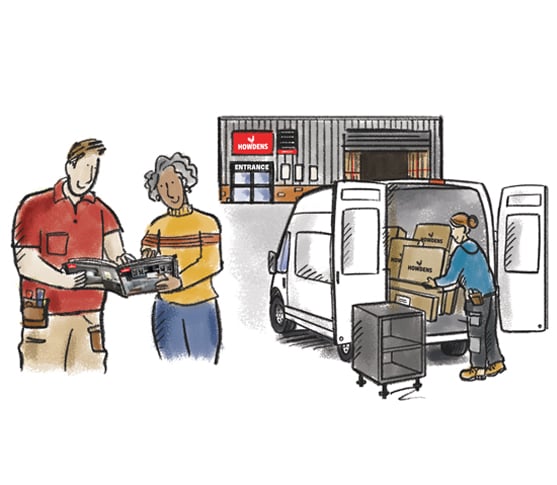
Business Model and Strategy
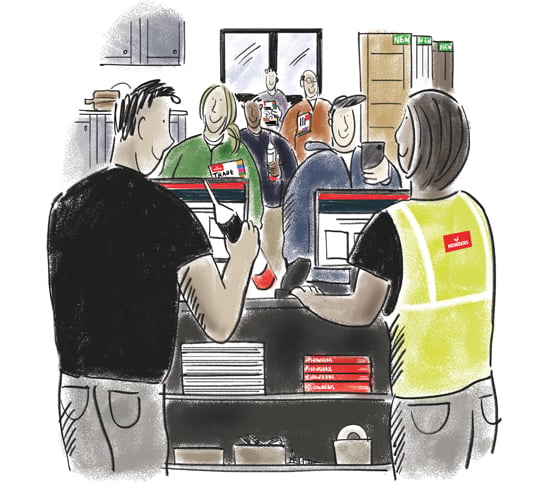
Depots
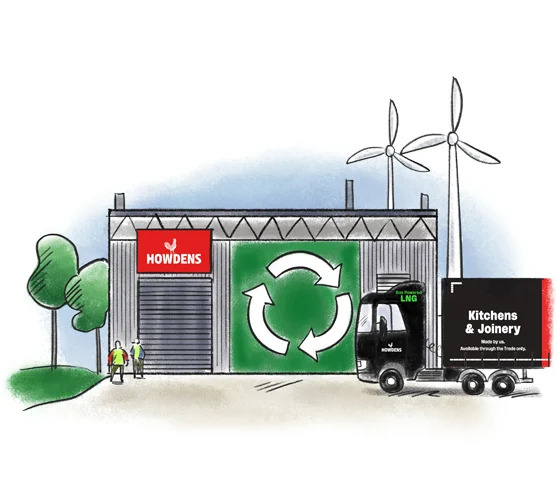
Sustainability
Community
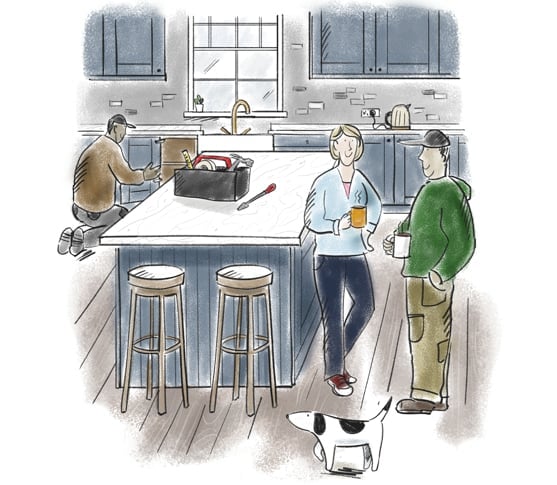
Products
People and Careers
